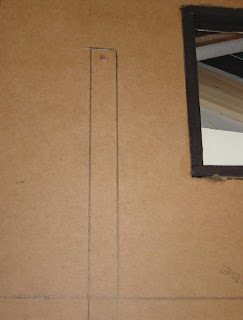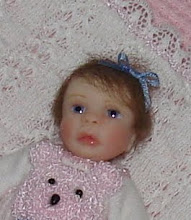Once our interior walls had the paperclay finished and had dried overnight we started to wire the house. There will be a chandelier from the beams upstairs, a candle stick on top of the mantle and a porch light with a wire set up on the interior wall at the same point. I added one more light source downstairs too. We measured 4 1/2" up the wall on the interior to make the first hole for the wires. It should end up being 5" up on the exterior wall. I lined it up by the front door for the porch light. We used a bamboo stylus tool that Rik had made with a handle.
Now, You turn the wall to the exterior and draw a 1/4" line around the hole that you will use for the wiring.
Take your Stanley knife and hold it at a 45 degree angle and cut out a channel that your wiring will fit into.
Keep sharp blades in this knife at all times! It makes the job so much easier!

Your wiring will fit inside this channel just perfectly! I really loved finding out about this so much. You put your wire for the interior fixture into the channel that you have just cut and tie a small knot (interior side) in the wire to keep it in place. The next step is to carefully put a line of glue around the edge of the channel that you have just cut out,being very careful not to get it near any of the wiring. Glue a piece of Bristol board over the channel so it is protected. You can check your wiring after the bristol board has dried to make sure that you can move it freely and no glue has touched it. If you have a light source outside at that point(my porch light) you then make a hole in the bristol board and feed a wire from the outside into the channel and tie a loose knot in that to have it stay in place until you are wiring up your lights. You can coil both wires up and tape them to the interior wall while you paperclay the exterior wall. Your wiring is completely covered up and protected!!


It is such a great method to wire a house!!! I am hoping that when I am at a point to attach lights and the final step of connecting the wiring underneath the house it goes smoothly!



 In the last picture you can see in the corner where the two walls meet my paperclay has a gap. I need to put a small amount of glue there and add some paperclay to fill in the gap. I was really happy to see that my baseboards ended up at the right level when the house was put together. Less work at that point. I have all of the wood for the roof prepainted and can start adding them. I also need to add a little more "wash" over my bricks. For a wash for your grout color it is about 1/2 cup water with 2 drops pf Hippo Grey and 1 drop of black paint added. You can adjust that formula to fit your needs. Once the bricks are completely painted I will add some more paperclay over parts of them so it looks like over the years it has fallen off, exposing the brick.
In the last picture you can see in the corner where the two walls meet my paperclay has a gap. I need to put a small amount of glue there and add some paperclay to fill in the gap. I was really happy to see that my baseboards ended up at the right level when the house was put together. Less work at that point. I have all of the wood for the roof prepainted and can start adding them. I also need to add a little more "wash" over my bricks. For a wash for your grout color it is about 1/2 cup water with 2 drops pf Hippo Grey and 1 drop of black paint added. You can adjust that formula to fit your needs. Once the bricks are completely painted I will add some more paperclay over parts of them so it looks like over the years it has fallen off, exposing the brick.

















.jpg)




































.jpg)














